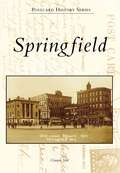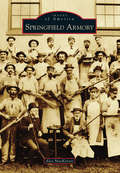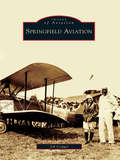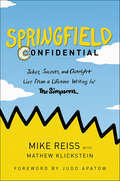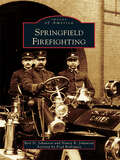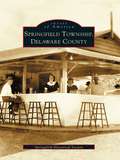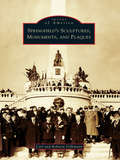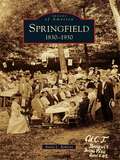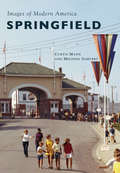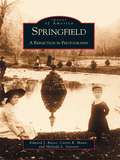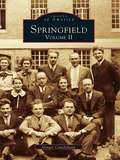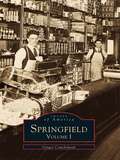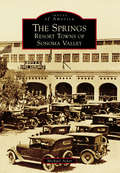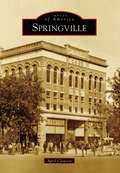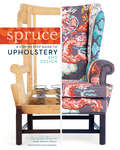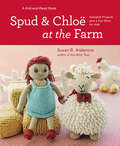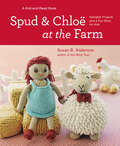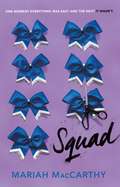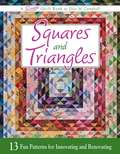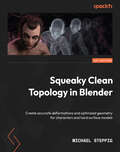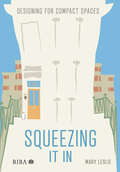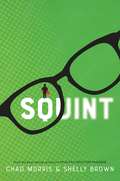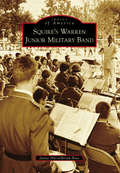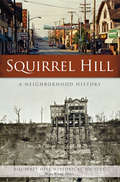- Table View
- List View
Springfield (Postcard History Series)
by Connie YenKnown as the "Queen City of the Ozarks," Springfield was founded in 1829 and became the seat of Greene County in 1835. Beginning in 1870, Springfield served as a railroad hub that connected the Ozarks culturally and financially to Kansas City, St. Louis, Chicago, and points along the East Coast. In 1938, Route 66 became part of the city's history when the legendary highway came through the public square on College Street. Built on land donated by Springfield founder John Polk Campbell, the square continues to be a vital part of the city's culture and economy. Postcard History Series: Springfield illustrates the community's growth from downtown businesses to the spread of schools, hospitals, and parks across the city.
Springfield Armory (Images of America)
by Alex MackenziePres. George Washington authorized Springfield Armory to begin manufacturing small arms for the US military in 1794. Over nearly two centuries until its closure in 1968, the government armory at Springfield, Massachusetts, became legendary, not only for the arms provided to soldiers during conflicts such as the War of 1812, the Civil War, and World War II, but also for the way in which those arms were crafted. The drive to produce firearms of high quality and quantity for the nation's military created a need to improve manufacturing methods and machinery. Armory advancements, such as the interchangeability of parts, helped lay the groundwork of the American Industrial Revolution. Because of these efforts, Springfield Armory is recognized not only as a first-rate government arms manufacturer, but also as a hub of industry, attracting thousands of skilled men and women from around the world.
Springfield Aviation (Images of Aviation)
by Job CongerCitizens of Springfield first witnessed human flight, a balloon ascent, on July 5, 1858. In 1861, the capital city's most famous resident, Abraham Lincoln, then residing in the White House, authorized the creation of the first U.S. "air force," a balloon to observe Confederate troops. Springfield's interface with aviation has been a steady stream of hot-and-cold-running enthusiasm since airplanes began flying from the state fair racetrack infield about 1910. Springfield Aviation chronicles that flow and concludes with photographs from Abraham Lincoln Capital Airport in early 2008. It presents photographs of memorable airplanes, airships, and prominent aviators from the author's extensive collection, augmented by contributions from Springfield Airport Authority, Lincoln Library's Sangamon Valley Collection, and many others.
Springfield Confidential: Jokes, Secrets, and Outright Lies from a Lifetime Writing for The Simpsons
by Mathew Klickstein Mike ReissSemi-Finalist for the 2019 James Thurber Award * One of Vulture's Top-10 Comedy Books of 2018 * A "Must" pick by Entertainment Weekly * An A.V. Club Best Books selection * A "New and Noteworthy" selection by USA TodayIn celebration of The Simpsons thirtieth anniversary, the show’s longest-serving writer and producer offers a humorous look at the writing and making of the legendary Fox series that has become one of the most revered artistic achievements in television history.Four-time Emmy winner Mike Reiss—who has worked on The Simpsons continuously since episode one in 1989—shares stories, scandals, and gossip about working with America’s most iconic cartoon family ever. Reiss explains how the episodes are created, and provides an inside look at the show’s writers, animators, actors and celebrity guests. He answers a range of questions from Simpsons fans and die-hards, and reminisces about the making of perennially favorite episodes.In his freewheeling, irreverent comic style, Reiss reflects on his lifetime inside The Simpsons—a personal highlights reel of his achievements, observations, and favorite stories. Springfield Confidential exposes why Matt Groening decided to make all of the characters yellow; dishes on what it’s like to be crammed in a room full of funny writers sixty hours a week; and tells what Reiss learned after traveling to seventy-one countries where The Simpsons is watched (ironic note: there’s no electricity in many of these places); and even reveals where Springfield is located! He features unique interviews with Judd Apatow, who also provided the foreword, and Conan O'Brien, as well as with Simpsons legends Al Jean, Nancy Cartwright, Dan Castellaneta, and more. Like Cary Elwes’ As You Wish, Jennifer Keishin Armstrong’s Seinfeldia, and Chris Smith’s The Daily Show: An Oral History, Springfield Confidential is a funny, informational, and exclusive look at one of the most beloved programs in all of television land.
Springfield Firefighting (Images of America)
by Fred Rodriguez Bert D. Johanson Nancy B. JohansonThe history of the Springfield Fire Department dates back to 1792 when the first hand pumper, Lion, was purchased. On January 24, 1794, a fire club with 50 members, all prominent citizens of the city, was organized. Fire districts were established in 1830 by an act passed by the Massachusetts legislature. By 1833, Springfield officially organized a fire department, and like the fire club, the new volunteer department consisted of prominent members of the community. The fire department changed from volunteer to paid in 1872. The volunteers then formed the Springfield Veteran Fireman's Association. After 1872, the department made great strides, especially in the area of apparatus. In 1906, Springfield entered the motorized age with the introduction of a Knox squad truck, and by 1916, Springfield became the first fullymotorized fire department in the United States.
Springfield Township, Delaware County (Images of America)
by Springfield Historical SocietyCarved out of the wilderness in the 1680s, Springfield Township was formed as Quaker families seeking religious freedom settled the area. In a region roughly bounded by Darby Creek to the east and Crum Creek to the west, the early settlers shared forests with the native Lenni Lenape tribe. Just nine miles west of the port of Philadelphia, Springfield harnessed tumbling creeks with mills during the industrial revolution and provided the growing commonwealth with edge tools from Beatty Ax Works and fabric from Victoria Plush Mill. Builders used abundant stone quarries to construct grand homes, including that of the Pennsylvania Railroad's first chief engineer, J. Edgar Thomson, who laid out the famous Horseshoe Curve and Main Line to Pittsburgh. The construction of the Media Shortline Trolley helped Springfield grow, as did the Saxon Avenue Shops and unique developments such as Windsor Circle and Rolling Road. Springfield Township documents the area's transformation into a modern town rich with amenities and community organizations.
Springfield's Sculptures, Monuments, and Plaques
by Carl Volkmann Roberta VolkmannSpringfield is the capital of Illinois and the home of Abraham Lincoln and Vachel Lindsay. The city is filled with history, and that fact is reflected in the many sculptures, monuments, and plaques that have been commissioned to commemorate this history. The city contains more than 14 statues and busts of Abraham Lincoln. Famous sculptors have created 17 statues inside the state capitol alone, and 13 more statues and sculptures are located on the capitol grounds. The state's Capital Development Board sponsors the Art-in-Architecture program and provides funding for newly commissioned sculptures in state-funded public buildings. Several major American sculptors are represented in the many works, including Leonard Volk, Leonard Crunelle, Larkin Mead, Fred Torrey, and James Earl Fraser. Works of contemporary artists such as Michael Dunbar, Richard Hunt, and Preston Jackson are also present. Oak Ridge Cemetery contains four war memorials and Abraham Lincoln's tomb. Each of the sculptures, monuments, and plaques has a story to tell and helps to make Springfield's history come alive.
Springfield: 1830-1930
by Anita L. RobertsSpringfield, now the third-largest city in the state, was once an area favored by Native Americans for its natural beauty, mild climate, abundant timber, and excellent hunting and fishing. Founded by John Polk Campbell in 1829, the settlement grew steadily, thanks to its civic-minded residents. Springfield's many photographs show these diligent people at work as well as at play. Whether enjoying a vaudeville show at the Landers Theatre in 1891, riding a jitney or streetcar to Doling Park in 1915, or playing in the world's largest Boy Scout Band in 1925, the people of Springfield enjoyed themselves. Images depict businesses such as the Springfield Wagon Company, which became "king" of U.S. wagon manufacturing, and the "Frisco," whose operational hub was housed in Springfield, bringing commercial and industrial diversification. In 1926, the city became the birthplace of the Mother Road, Route 66, which firmly established Springfield's right to the name "Queen City of the Ozarks."
Springfield: A Reflection In Photography (Images of Modern America)
by Curtis Mann Melinda GarvertThe 1960s and 1970s were a time of significant change in the history of Springfield, Illinois, as the city redefined itself through major developments in education, technology, and commerce. This pictorial history allows readers to remember the familiar places of those decades, such as the downtown area, and acquaint themselves with the history of the new institutions that started in this time period. Colorful images, many taken by amateur photographers, document the theme of change in the landscape and culture of Springfield as the city moved into the future.
Springfield: A Reflection in Photography
by Curtis R. Mann Melinda L. Garvert Edward J. RussoSpringfield: A Reflection in Photography is a photo album of Springfield scenes from the late 19th through the mid 20th centuries-a nostalgic look back at everyday life in the capital city. Local people are seen at work, at play and socializing. Iron workers, construction crews and munitions makers show us the gritty, tiring work of a community and emphasize the man and animal power once common in industry. There are social changes as well, like the coming of women to the workplace. Shirtwaisted ladies at the Illinois Watch Company and "Rosie the Riveter" on the production line during the war make their appearance. Aerial views of the downtown area present a century of change in Springfield. The evolution of transportation in the community is chronicled, from horse and buggy to the railroad to the automobile. Images of ladies cooking at Temple and crews preparing community garden plots showcase the city's volunteer service heritage. Commonplace images of life in Springfield, such as children at play, shopping, parades, and the first day of school, are all presented here. But the less common events are included as well: fires, the race riot, even a baptism at Lake Springfield. Together, these images tell the story of who we were, and perhaps more importantly, who we have become as a result. This book shows a community readers may know intimately, yet have never seen.
Springfield: Volume I
by Ginger CruickshankSituated at the crossroads of New England, Springfield, Massachusetts, was founded in 1636 by twelve families led by William Pynchon, who named the settlement after his birthplace in England. This book, the first of a two-volume set, is a collection of many never-before-seen photographs that tell the story of this city's history. Springfield is a city of "firsts." The first successful gasoline-poweredengine was built by the Duryea brothers here; the first U.S. musket was made at the Springfield Armory; and in 1891, resident Dr. James Naismith invented the game of basketball. The city's ties to the U.S. military are illustrated here, as are its many religious and ethnic communities. Within these pages, we can see images of a very different Springfield, including buildings much changed or long gone, and people remembered now in family albums.
Springfield: Volume I
by Ginger CruickshankSituated at the crossroads of New England, Springfield, Massachusetts, was founded in 1636 by twelve families led by William Pynchon, who named the settlement after his birthplace in England. This book, the first of a two-volume set, is a collection of many never-before-seen photographs that tell the story of this city’s history. Springfield is a city of “firsts.” The first successful gasoline-poweredengine was built by the Duryea brothers here; the first U.S. musket was made at the Springfield Armory; and in 1891, resident Dr. James Naismith invented the game of basketball. The city’s ties to the U.S. military are illustrated here, as are its many religious and ethnic communities. Within these pages, we can see images of a very different Springfield, including buildings much changed or long gone, and people remembered now in family albums.
Springs, The: Resort Towns of Sonoma Valley (Images of America)
by Michael AckerThe Springs area of Sonoma Valley has a fascinating history going back to Spanish colonization of California, continuing through the Mexican period with Vallejo and the mid-19th-century sojourns of Hooker and Leavenworth, and moving into the flowering of the geothermal resort era in the 1880s. Eventually, the unincorporated towns of Boyes Hot Springs, Fetters Hot Springs, Agua Caliente, and El Verano became collectively known as The Springs, which were thriving resort communities from the 1880s through the 1960s. Sharing an illustrious history with the adjacent city of Sonoma, they continue to thrive in new ways into the 21st century. In this volume, the story of the valley is well documented in postcards, snapshots, and newspaper photographs and articles.
Springville (Images of America)
by April ClawsonLocated south of Provo, Utah, is artistic Springville. In 1776, Catholic explorers were the first to map this region. Native Americans enjoyed this locale for its abundance of wild game and its ready access to water. Brigham Young, a president of the Church of Jesus Christ of Latter-day Saints, asked men to examine the area in 1848. Capt. Aaron Johnson and the few families who were asked to settle here arrived in mid-afternoon on September 18, 1850. Hobble Creek was the first name given to the settlement, and that title is still used today by some local venues. In 1853, the Legislative Assembly of the Territory of Utah approved the city charter, and the first municipal election took place. Springville was then officially named after the large springs in the vicinity.
Spruce: A Step-by-step Guide To Upholstery And Design
by Grace Bonney Amanda BrownDiscover the joys of upholstery and bring new life to your worn-out furniture. With a few basic tools, an eye for color, and some ingenuity, you can customize your home with fabrics and textures that reflect your unique personality. This comprehensive guide features more than 900 photographs and includes five projects designed to teach you all you need to know to reupholster any piece of furniture. You’ll soon be confidently stripping down old sofas, stuffing sagging ottomans, and revamping chairs with your own distinctive style.
Spud and Chloe at the Farm: Enhanced Version
by Susan B. AndersonA knit-and-read book: 13 farm-centric projects for the perfect homespun toys, with a bonus story. A mother hen and her chicks (and their adorable knitted eggshells), three little piglets, and a black lamb full of good intentions are just some of the appealing projects in Spud and Chloë at the Farm, the latest innovative work from author and world-class knitter Susan B.Anderson. The projects in this book follow Spud, a feisty pet sheep, and Chloë, his perky owner, as they travel to a farm and meet the inhabitants of the barnyard, including a brown cow, some mice, a dog, and a barn cat. To continue the theme, and set the stage for loads of interactive play, the book also offers instructions for making an assortment of farm props, such as a picket fence, bales of hay, dainty baskets, and even a three-sided foldable barn.Meanwhile, witty full-color cartoons (presented one per spread throughout the text of the book) tell the story of Spud and Chloë’s visit to the farm, which starts with an invitation from Spud’s cousin Little Lamb. Featuring charming full-color photographs of the knitted toys, this book is a must-have for knitters and their loved ones.
Spud and Chloe at the Farm: Regular Version
by Susan B. AndersonA knit-and-read book: 13 farm-centric projects for the perfect homespun toys, with a bonus story. A mother hen and her chicks (and their adorable knitted eggshells), three little piglets, and a black lamb full of good intentions are just some of the appealing projects in Spud and Chloë at the Farm, the latest innovative work from author and world-class knitter Susan B.Anderson. The projects in this book follow Spud, a feisty pet sheep, and Chloë, his perky owner, as they travel to a farm and meet the inhabitants of the barnyard, including a brown cow, some mice, a dog, and a barn cat. To continue the theme, and set the stage for loads of interactive play, the book also offers instructions for making an assortment of farm props, such as a picket fence, bales of hay, dainty baskets, and even a three-sided foldable barn.Meanwhile, witty full-color cartoons (presented one per spread throughout the text of the book) tell the story of Spud and Chloë’s visit to the farm, which starts with an invitation from Spud’s cousin Little Lamb. Featuring charming full-color photographs of the knitted toys, this book is a must-have for knitters and their loved ones.
Squad
by Mariah MacCarthy*A Barnes & Noble Teen Blog's Most Anticipated LGBTQAP YA Book of 2019*Jenna Watson is a cheerleader. And she wants you to know it’s not some Hollywood crap: they are not every guy’s fantasy. They are not the “mean girls” of Marsen High School. They’re literally just human females trying to live their lives and do a perfect toe touch. And their team is at the top of their game. They’re a family.But all that changes when Jenna’s best friend stops talking to her. Suddenly, she’s not getting invited out with the rest of the squad. She’s always a step behind. And she has no idea why. While grappling with post-cheer life, Jenna explores things she never allowed herself to like, including LARPing (live action role playing) and a relationship with a trans guy that feels a lot like love. When Jenna loses the sport and the friends she’s always loved, she has to ask herself: What else is left?
Squares and Triangles: 13 Fun Patterns For Innovating And Renovating
by Elsie CampbellOnce again, expert quilt designer Elsie Campbell presents a book of quilt patterns that are one part innovation, one part thrift, and a whole lot of fun! Squares and Triangles, the second in Campbell's "Scrap Quilt Book Series," offers 13 basic but boldly sophisticated patterns. If you're a beginner, you'll want the book for its clear instructions and easy piecing steps. If you're more experienced, you'll love the versatility and nearly innumerable number of design possibilities shown here. Making the book a must-have are "Elsie's Top Tips for Squares and Triangle Quilts," complete with full-color diagrams. Says Campbell, "My favorite part of quiltmaking is playing with color and value so that I give a contemporary twist to traditional blocks and patterns." She does it here-with 13 quilts shown in full-color photography, along with easy-to-follow instructions, patterns, and diagrams for making each one. For beginning and intermediate quilters.
Squatters in the Capitalist City: Housing, Justice, and Urban Politics (Housing and Society Series)
by Miguel MartinezTo date, there has been no comprehensive analysis of the disperse research on the squatters’ movement in Europe. In Squatters in the Capitalist City, Miguel A. Martínez López presents a critical review of the current research on squatting and of the historical development of the movements in European cities according to their major social, political and spatial dimensions. Comparing cities, contexts, and the achievements of the squatters’ movements, this book presents the view that squatting is not simply a set of isolated, illegal and marginal practices, but is a long-lasting urban and transnational movement with significant and broad implications. While intersecting with different housing struggles, squatters face various aspects of urban politics and enhance the content of the movements claiming for a ‘right to the city.’ Squatters in the Capitalist City seeks to understand both the socio-spatial and political conditions favourable to the emergence and development of squatting, and the nature of the interactions between squatters, authorities and property owners by discussing the trajectory, features and limitations of squatting as a potential radicalisation of urban democracy.
Squeaky Clean Topology in Blender: Create accurate deformations and optimized geometry for characters and hard surface models
by Pablo Deeleman Michael SteppigA comprehensive introduction to 3D modeling, from the fundamental ideas of topology to in-depth examples that will help you take your projects to the next levelKey FeaturesOvercome complex topology problems while working through projectsLearn to topologize quad-based and non-quad-based meshes with step-by-step examplesOptimize your models by reducing the triangle count to improve performanceBook DescriptionThis book is an introduction to modeling and an in-depth look at topology in Blender, written by a Blender topology specialist with years of experience with the software. As you progress through its chapters, you'll conquer the basics of quad-based topology using triangles and Ngons, and learn best practices and things to avoid while modeling and retopologizing. The pages are full of illustrations and examples with in-depth explanations that showcase each step in an easy-to-follow format.Squeaky Clean Topology in Blender starts by introducing you to the user interface and navigation. It then goes through an overview of the modeling techniques and hotkeys that will be necessary to understand the examples. With the modeling basics out of the way, the next stop on our journey is topology. Working through projects like a character and a sci-fi blaster, the book will illustrate and work through complex topology problems, and present solutions to those problems. These examples focus on deforming character models, non-deforming hard surface models, and optimizing these models by reducing the triangle count.By the end of this book, you will be able to identify the general flow of a shape's topology, identify and solve issues in your topology, and come out with a model ready for UV unwrapping, materials, and rigging.What you will learnIdentify the general flow of a model's topology, and what might cause issuesUnderstand the topology of a character, and the joints that they make upHandle non-quad based topologyLay out your meshes for UV seamsExplore and use hotkeys to get things done fasterOptimize models for a reduced triangle countWho this book is forThis book is for character modelers, sculptors, poly modelers, and hard surface modelers. Whether you're looking for an introduction to modeling, optimizing high poly or sculpted models, or just a deeper dive into the subject of topology, this book will walk you through the topology workflow from beginning to end.
Squeezing It In: Designing for compact spaces
by Mary LeslieOur living spaces are getting smaller but, as we spend more time at home, they must now work harder than ever to provide us with room to relax, work and entertain. Interior designers need to understand how to build accessibility, circulation, storage and lighting into the most restricted areas, without compromising on style. In this jargon-free guide, Mary Leslie demonstrates how to design for compact living, proposing creative solutions that can be applied to a variety of settings. A versatile designer may be addressing a cramped studio flat one day and a dressing room for an international business traveller the next; this book provides inspiration and advice for every kind of small space, and every budget. Organised around the different areas of the home, Squeezing It In examines familiar problems and offers clever, immediately applicable ideas for making the best of pocket-sized spaces. The entire design process is considered alongside complete examples, from the UK and internationally, which are generously illustrated with full-colour photographs, plans and sketches. Featuring case studies from: Archio Ltd Armstrong Keyworth Benjamin Tindall Architects Darren Oldfield Architects Jeffreys Interiors Papa Architects Peden & Pringle Plankbridge Ltd.
Squint
by Chad Morris Shelly BrownMy name is Flint, but everyone in middle school calls me Squint because I'm losing my vision. I used to play football, but not anymore. I haven t had a friend in a long time. Thankfully, real friends can see the real you, even when you can't clearly see. Flint loves to draw. In fact, he's furiously trying to finish his comic book so he can be the youngest winner of the Find a Comic Star contest. He s also rushing to finish because he has keratoconus an eye disease that could eventually make him blind. <P><P>McKell is the new girl at school and immediately hangs with the popular kids. Except McKell's not a fan of the way her friends treat this boy named Squint. He seems nice and really talented. He draws awesome pictures of superheroes. McKell wants to get to know him, but is it worth the risk? What if her friends catch her hanging with the kid who squints all the time? <P><P>McKell has a hidden talent of her own but doesn't share it for fear of being judged. Her terminally ill brother, Danny, challenges McKell to share her love of poetry and songwriting. Flint seems like someone she could trust. Someone who would never laugh at her. Someone who is as good and brave as the superhero in Flint's comic book named Squint. <P><P>Squint is the inspiring story of two new friends dealing with their own challenges, who learn to trust each other, believe in themselves, and begin to truly see what matters most.
Squire's Warren Junior Military Band (Images of America)
by Janne Hurrelbrink-BiasSquire�s Warren Junior Military Band had an emotional appeal that endeared it to audiences of all ages. Considered one of northeastern Ohio�s richest artistic assets, the band�s members, who hailed from the entire region, were filled with pride, tradition, patriotism, and a sense of discipline. The original VFW Boys Band was formed in 1927, with Donald W. �Squire� Hurrelbrink becoming director in 1930. In 1957, the name changed to the Warren Junior Military Band. Travels took the band from the East Coast to the West Coast, from Canada to the Gulf of Mexico, and to audiences abroad, amassing an impressive record of Midwest, Canadian, European, American Legion, and VFW National Championships. Throughout the years, the band performed at numerous prestigious events and for an impressive number of dignitaries, as well as a phenomenal number of local, civic, and patriotic festivities. Members were privileged to have Squire�s leadership for 66 years. Alumni continued to lead, direct, and pass on the values they learned under Squire�s guidance. Finally, in 2010, the band ended its long legacy.
Squirrel Hill: A Neighborhood History (American Chronicles)
by Editor Helen Wilson Squirrel Hill Historical SocietyPittsburgh’s Squirrel Hill neighborhood began on the frontier of western Pennsylvania 250 years ago and developed into a vibrant urban community. Early settler John Turner, half brother of renegade Simon Girty, survived capture by Native Americans and experienced firsthand the change from dangerous wilderness to established farming community. Wealthy landowners Henry Clay Frick and Mary Schenley bestowed Squirrel Hill its grand public parks. Hyman Little, Herman Kamin and countless others moved to the hill and made it Pittsburgh’s premier Jewish community, with a tightknit cluster of synagogues, temples and a thriving business district. The Squirrel Hill Historical Society and editor Helen Wilson explore the fascinating history of one of Pittsburgh’s historic neighborhoods.
